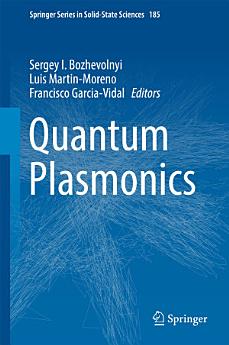Quantum Plasmonics
Sobre aquest llibre
Sobre l'autor
CV of Prof. S. I. Bozhevolnyi
Sergey I. Bozhevolnyi has received the degrees of M.Sc. in physics (1978) and Ph.D. in quantum electronics (1981) from the Moscow Physical Technical Institute, a.k.a. “FizTech”, and Dr.Scient. from Aarhus University, Denmark (1998). He has been working at Aalborg University (Denmark) in 1991-2008. During 2001–2004, he was also the Chief Technical Officer (CTO) of Micro Managed Photons A/S set up to commercialize plasmonic waveguides. Since February 2008 he is a professor at the University of Southern Denmark (Odense), heading since 2013 the Centre for Nano Optics. His research interests include linear and nonlinear nano-optics and nanophotonics, including multiple light scattering phenomena, surface plasmon polaritons and nano-plasmonic circuits. He has (co-) authored more than 400 scientific publications in peer-reviewed journals (citations > 12000, h-index: 50). Prof. Bozhevolnyi is a Fellow of the Optical Society of America.
CV of Prof. L. Martin-Moreno
Luis Martin-Moreno has received the degrees of M.Sc. in physics (1985) and Ph.D. (1989) from Universidad Autonoma de Madrid (Spain). He has been working at Universidad Autonoma de Madrid and Universidad de Zaragoza, before becoming a Professor at the Instituto de Ciencia de Materiales de Aragon (Consejo Superior de Investigaciones Cienticas) since 2008. His research interests include theoretical electrodynamics and solid-state physics, including plasmonics, metamaterials, acoustics and graphene. He has (co-) authored more than 210 scientific publications in peer-reviewed journals (citations > 11900, h-index: 52). Prof. L. Martin-Moreno was selected in 2014 as Highly Cited Researcher by Thomson Reuters based on the scientific publications during the previous 10 years.
CV of Prof. F. J. García-Vidal
Francisco J. García-Vidal has received the degrees of M.Sc. in physics (1988) and Ph.D. (1992) from Universidad Autonoma de Madrid (Spain). He has been working at Universidad Autonoma de Madrid since 1992, becoming a Full Professor in 2007, and as a guest researcher at Imperial College London, Université Louis Pasteur (Strasbourg) and University of California. His research interests include theoretical electrodynamics and solid-state physics, including plasmonics, metamaterials, acoustics and graphene. He has (co-) authored more than 210 scientific publications in peer-reviewed journals (citations > 13900, h-index: 53). Prof. F. J. García-Vidal was selected in 2014 for the list of the 144 most influential physicists of the decade 2002-2012 elaborated by Thomson Reuters.




